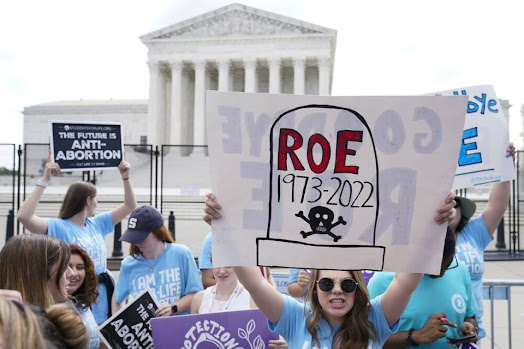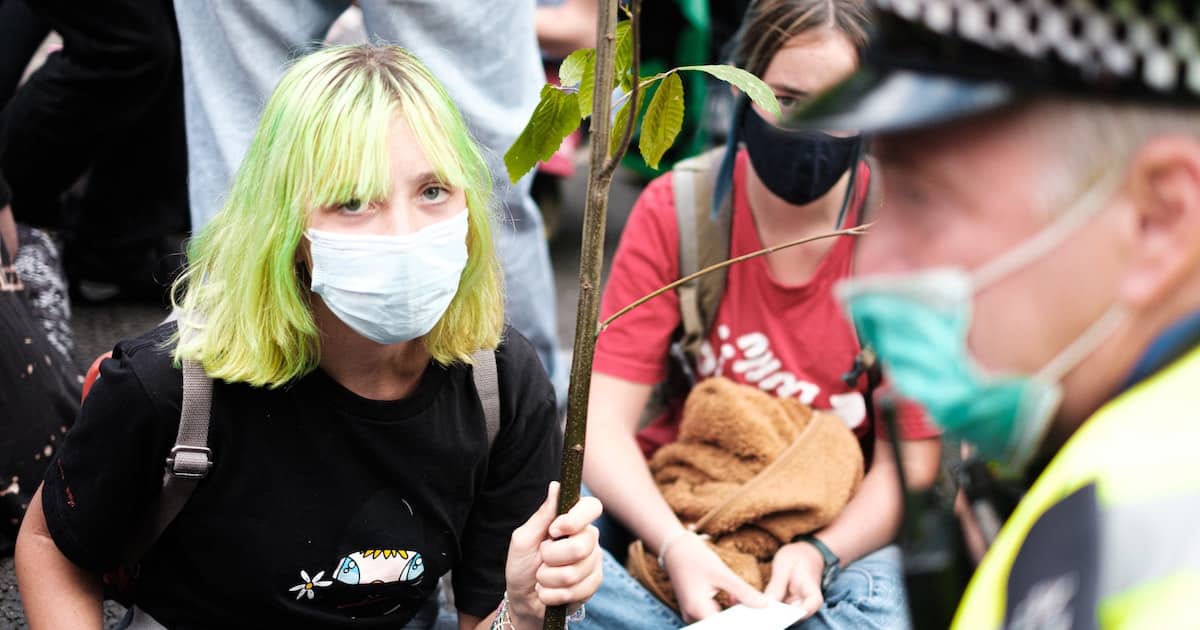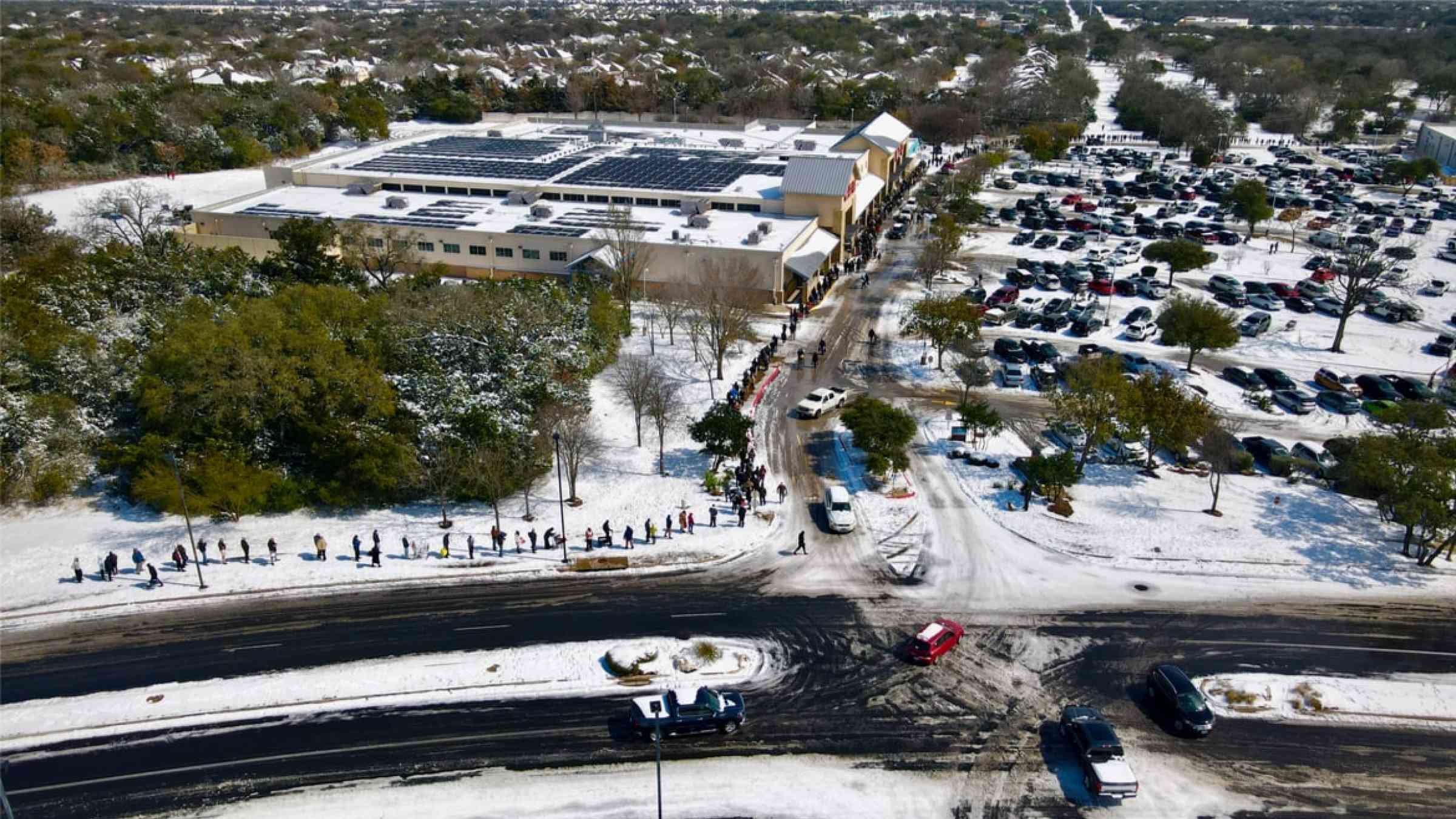by Anne Lofaso | Jun 28, 2022
On Friday, June 24, 2022, in Dobbs v Jackson Women’s Health Organization, the United States Supreme Court in a 5–4 decision spanning over two-hundred pages, overruled Roe v Wade and Planned Parenthood of Southeastern Pennsylvania v Casey, cases which had interpreted the U.S. Constitution as protecting a women’s liberty to choose an abortion up to fetal viability. In one swoop of the judicial quill, five Justices—Samuel Alito, Clarence Thomas, Neil Gorsuch, Brett Kavanaugh, and Amy Coney Barrett—erased a half-century of U.S. American women’s reproductive freedom. This blog series explores how Dobbs may impact the human rights of women, minorities, LGBTQIA+ individuals, the poor, and other marginalised communities.
Dobbs’ 213-page decision, includes Justice Alito’s 108-page majority decision, joined by Justices Thomas, Gorsuch, Kavanaugh, and Barrett; three separate, concurring opinions; and one dissenting opinion written jointly by Justices Breyer, Sotomayor, and Kagan. Examining a Mississippi state law banning abortion after fifteen weeks, the Alito-authored majority opinion framed the issue narrowly—whether a woman has a right to an abortion—as opposed to whether a woman has a right to bodily autonomy free from government interference. The opinion proceeded in three main parts. First, the majority reviewed the standards set forth in its jurisprudence interpreting the Fourteenth Amendment’s Substantive Due Process Clause, which prohibits “any State” from “depriv[ing] any person of . . . liberty . . . without due process of law”. In its review, the majority found that the U.S. Constitution makes no mention of the word abortion. It also rejected applying the Fourteenth Amendment’s Equal Protection Clause, which prohibits the states from “deny[ing] to any person within its jurisdiction the equal protection of the laws,” on the ironic grounds that its own Equal Protection jurisprudence dictates that state regulations of abortion are not prohibited sex-based classifications.
Second, the majority examined whether the right to an abortion is “deeply rooted in this Nation’s history and tradition” and “implicit in the concept of ordered liberty”. Relying on a survey of state law as it existed in 1868, the Fourteenth Amendment’s ratification year, and the views of English jurists Henry de Bracton (1210–1268), Sir Edward Coke (1552–1634), Sir Matthew Hale (1609–1676), and Sir William Blackstone (1723–1780), the Court concluded that there simply is no such deeply rooted tradition and therefore no basis for creating such a right.
Third, having determined that neither the Constitution’s text nor U.S. American legal history supports a finding of a right to abortion, the majority reviewed whether Roe and Casey are entitled to stare decisis, the legal doctrine that the Court will adhere to prior legal precedent in making its decisions. The majority acknowledged that stare decisis is critical for legal stability in the U.S. system. However, the majority and especially Justice Kavanaugh’s concurrence concluded that these prior decisions were not entitled to such adherence because they were “egregiously wrong,” had “caused significant negative jurisprudential or real-world consequences,” and overruling them “would not unduly upset legitimate reliance interests”.
Justice Thomas’s concurrence is notable for its proclamation that cases such as Griswold v Connecticut (right to contraception); Lawrence v Texas (right to engage in private, consensual intimate acts); Obergefell v Hodges (right to same-sex marriage) should be reconsidered along with all substantive due process precedents. In Thomas’ view, these cases were all erroneously decided, although he leaves open the possibility that another section of the Constitution may protect some of these rights.
Chief Justice Roberts’ opinion, concurring in judgment only, is also notable for its self-proclaimed “measured course”. While Roberts agreed with the majority to “discard[]” Roe and Casey’s viability line because it “never made any sense,” he would have reframed the right as the women’s right to make reproductive choices. Roberts explained that the “right should therefore extend far enough to ensure a reasonable opportunity to choose, but need not extend any further—certainly not all the way to viability”. Roberts thereby concluded that the Mississippi fifteen-week abortion ban “provides sufficient time, absent rare circumstances, for a woman ‘to decide for herself’ whether to terminate her pregnancy”.
The jointly written, sixty-six-page dissent reaffirmed Roe and Casey. According to the dissent, those decisions were entitled to stare decisis because they were rightly—not wrongly—decided and have proven workable in practice. The dissent’s most significant observation, however, was its “prophecy” of how Dobbs will affect future rights. Taking no comfort in the majority’s assurances that Dobbs is limited to abortion, the dissent reminds us that “[r]ights can contract in the same way and for the same reason”. After all, there is “no historical right to contraception” or same-sex marriage or inter-racial marriage.
What does not seem to be in jeopardy, however, is the First Amendment’s protection of the rights of free speech and to petition the Government to redress grievances. We will surely see those rights exercised for years to come.

About Anne Lofaso
Anne Marie Lofaso is the Arthur B. Hodges Professor of Law at West Virginia University College of Law. She was formerly the WVU Law Associate Dean for Faculty Research and Development (2011-2015) and a Leadership Fellow in the WVU Office of the Associate Vice President for Creative and Scholarly Activities. She has previously taught at American University Washington College of Law and at the University of Oxford.
Abortion rights: Regressive developments in Poland and US go against global trend

Pic: Aerial shot of protests against anti-abortion law, Warsaw, October 2020. lukszczepanski/Adobe Stock
In late June, the US Supreme Court overturned two previous rulings – Roe and Casey – that created a constitutional right to abortion and enabled states to ban abortion at any stage of pregnancy.
Within hours of the decision in the case Dobbs v Jackson Women’s Health Organization, ten states had banned abortion, and providers in some states have paused their services while questions about the implications of pre-Roe laws are resolved. In total, 26 states are expected to ban abortion quickly following the decision.
Rights advocates fear criminalisation of healthcare providers and people who have suspected abortions, as well as increased surveillance, denials of lifesaving care and restrictions on travelling to seek healthcare elsewhere.
Matt Kaiser, Vice-Chair of the IBA Criminal Law Committee and a partner at KaiserDillion in Washington, DC, says even before the decision ‘there have been investigations and prosecutions into certain pregnancy outcomes in some states. My understanding is that those are more attention-grabbing outliers than a regular national phenomenon, thankfully.’
In his view, Roe’s overturning means that the ‘floodgates will open […] and it will the worst of how prosecution is done’.
He adds that ‘you could have criminal trials that are really just conflicting medical testimony about, in this situation, how necessary was it to save the life of the mother?’
Others warn of the potential global impact of the ruling. Speaking after the decision appeared in leaked form in May, Mark Stephens, CBE, a Co-Chair of the IBA Human Rights Institute (IBAHRI), said that ‘the [anti-choice] abortion lobby globally is going to take enormous heart if this decision from the US Supreme Court remains as it currently is in its leaked draft.’
Denying women access to safe abortion can amount to violations of the rights to health, privacy and the right to be free from cruel, inhumane and degrading treatment
Anne Ramberg
Co-Chair, IBA’s Human Rights Institute
Akila Radhakrishnan is President of the US-based Global Justice Center, which works to further reproductive rights globally through the rule of law. She says, ‘there’s the potential for this to have regressive impact’, highlighting that many anti-choice organisations have a global footprint and that tactics used in the US have already been imported elsewhere. ‘We’ve seen the importing of tactics, for example, around protesting at clinics starting to crop up in Africa.’
But Margaret Harpin, Legal Advisor in the Global Legal Strategies Unit at the Center for Reproductive Rights in the US, highlights that regressive moves to restrict abortion go against a global trend. ‘Generally overall in the past 25 years, we’ve seen nearly 60 countries liberalise their abortion laws, and only three have rolled back rights’, she says.
In Poland, pregnant people face heightened scrutiny following an order from the Health Minister, signed in early June, requiring doctors to register all pregnancies in the country. Information collected will include past or current illnesses, medical visits, treatment and blood type.
In light of Poland’s near-total abortion ban, there are fears the register could be weaponised to monitor pregnancy outcomes and persecute women suspected of having abortions or suspected abortion providers – particularly as the information can be accessed by the Polish prosecutor’s office through a court order.
Anne Ramberg, also a Co-Chair of the IBAHRI, tells Global Insight that the ‘grotesquely repressive’ order ‘is of course an infringement of privacy and women’s rights’. She adds that it’s ‘another example of increased surveillance and monitoring of people. It does not belong in a democracy built on the rule of law.’
The announcement comes 18 months after Poland’s heavily restrictive abortion laws – which had already forced 80,000–200,000 women a year to seek illegal or foreign abortions – were superseded by a near-total abortion ban.
In October 2020, Poland’s Constitutional Tribunal ruled that allowing abortion in cases of severe and irreversible foetal abnormalities – the grounds for 98 per cent of Poland’s abortions in 2019 – was unconstitutional. The Tribunal claimed ‘an unborn child is a human being’ and Poland’s Constitution guarantees a right to life.
The ban sparked the country’s largest protests in decades, but came into effect in January 2021. It allows exceptions in cases of rape, incest or when the pregnancy threatens the life of the mother. However, the ban has been blamed for the deaths of two women who were allegedly denied abortions after their pregnancies went into crisis.
And despite the exceptions for rape, fewer than five abortions per year were carried out on these grounds in the ten years before Poland’s laws tightened in 2021. To get such an abortion, the woman must provide evidence of their rape through a certified letter from a public prosecutor.
These significant barriers to healthcare are also now affecting the millions of refugees fleeing Russia’s invasion of Ukraine, who have entered Poland and found themselves stripped of their reproductive rights. Organisations supporting access to reproductive healthcare have highlighted that many of the refugees have been raped and face re-traumatisation and even forced pregnancy if they’re unable to move further into Europe for healthcare.
Stephens believes the European Court of Human Rights (ECtHR) may see cases arising out of the conflict ‘because essentially, women are not being allowed access freely, or they’re impeded in getting access to medical health services. And essentially, they’re being required to carry an unwanted pregnancy. That, as we know, is a violation of international human rights law, including the rights to privacy and bodily autonomy.’
He adds that ‘Poland is probably going to be at the wrong end of one of these cases. Because it’s just not acceptable in international law to say to a woman you’ve got to move to Scandinavia or to Holland or wherever in order merely to seek medical assistance with your pregnancy. Medical assistance that you couldn’t achieve in Poland. That’s discriminatory.’
The ECtHR had already received over 1,000 applications challenging Poland’s abortion laws by July 2021, and notified the Polish government of 12 applications. The applicants claim the laws amount to a potential violation of their rights to private lives and freedom from ill treatment.
Ramberg highlights that the European Parliament declared access to safe abortion a human right in 2021. ‘Denying women access to safe abortion can amount to violations of the rights to health, privacy and the right to be free from cruel, inhumane and degrading treatment’, she says.
Jun 26, 202

On Friday, June 24th, 2022 the U.S. Supreme Court overturned Roe v. Wade.
On Friday, it was announced that the U.S. Supreme Court had reversed Roe v. Wade, which federally protects a person’s right to an abortion. As a result of the news, in major U.S. cities, there were mass protests and many expressed sorrow and anger on social media about the news. J. Carter, Esq. is a principal attorney at the Carter Law Group, an adjunct faculty member at Pepperdine Law School, and was sworn into the Supreme Court Attorney Bar. In an email Carter, who specializes in family, entertainment, business, and estate law, shared her thoughts about the Roe v. Wade reversal, some of the implications of this monumental decision, and how the reversal will disparately impact marginalized folks.
Janice Gassam Asare: What were your initial thoughts around the Roe v. Wade reversal decision? How will this decision impact our country?
Jehan “J.” Carter: The U.S. legal profession is less than 5% Black. There are even fewer Black attorneys than that which are a part of the Supreme Court Attorney Bar, to which I have the honor to be a part of. The recent decision to overturn Roe v. Wade is an important reminder of why we have to continue to fight for diversity in the legal profession even in the highest courts. In that vein, now more than ever, am I excited for Ketanji Brown Jackson to join the Court.
I am, however, disappointed that the conservative Justices with just one decision would turn back 50 years of precedent based on their political ties and personal beliefs. Women in my generation and younger now have less rights over our bodies than our mothers. I am afraid that this may lead to more women dying and other privacy laws being overturned like contraceptives, marriage equality and gay rights which Justice Clarence Thomas made clear he thought should be reconsidered in his written opinion. There are currently 26 states that have either total abortion bans, six to eight week bans or severe restrictions. Of those 26 states, 13 are ‘trigger’ states whose abortion bans and restrictions took effect automatically once Roe was overturned—Arkansas, Idaho, Kentucky, Louisiana, Mississippi, Missouri, North Dakota, Oklahoma, South Dakota, Tennessee, Texas, Utah, and Wyoming. While I was fortunate to be sworn in by all the justices including Ruth Bader Ginsburg shortly before she passed, I know this landmark decision has her rolling in her grave. This is a very sad moment for America, regardless of where you stand on the issue.

Jehan “J.” Carter, Esq. is a principal attorney at the Carter Law Group and an adjunct faculty member
Asare: Who will be most harmed by this decision?
Carter: I think that poor women of color and pregnant rape victims will be affected most by this decision. Poor women of color will not be able to afford the gas, flight and hotel fees to travel to a state not in the 26 that now restricts or bans abortions…on top of the fact that they may not be able to take more than one day off from work or have childcare for their other children while traveling. This decision also does not make an exception for women that have been raped including teenagers that are victims of incest. It does however, allow states to make an exception for medical emergencies so states like Texas, Louisiana, Idaho and Missouri have this allowance but all define medical emergency differently, which just adds to the chaos of this decision.
Asare: Some folks who are pro-life have made the argument that Planned Parenthood was created to control the Black population. What are your thoughts around that claim?
Carter: Abortion is a tough issue for most but I think, in particular, Black Americans are divided due sometimes to religious reasons but also because Planned Parenthoods historically have been made more available than primary care clinics in poor Black neighborhoods, which at a minimum, gives the appearance that the government was more willing to kill Black babies versus giving proper healthcare to the Black women in these same communities and some would even say a method of population control. This theory has been backed by some pointing to the fact that in 1939, Margaret Sanger, one of the founders of Planned Parenthood, started the Negro Project alongside Black leaders like W.E.B. DuBois, Mary McLeod Bethune, and Reverend Adam Clayton Powell, to bring access to birth control to Black communities in the south. While some argue the project was to place Black doctors and nurses in these communities to reduce mistrust of a racist healthcare system, it is also documented that Sanger lost control of the project to white male leadership that had different objectives from her.
Asare: What can a citizen who opposes this decision do, if they live in a state where abortions will become illegal?
Carter: If a woman lives in a state where her abortion is now illegal, she can travel to another state that does not have a restriction or ban. But as discussed earlier, this can be expensive and time-consuming depending on how far that next state is from this person. Also, which is probably the most shocking, you may be sued depending on where you live by traveling to another state to have an abortion done. [According to a recent statement from Governor Gavin Newsom’s office] ‘Missouri recently advanced a proposal to allow private citizens to sue Missouri residents who have an abortion out of state, as well as their providers and anyone who assists them in seeking an abortion.’ Texas and Oklahoma already have abortion legislation that allows private citizens to sue people who perform abortions or who otherwise help someone get one inside of their states. For those that want to continue to learn more and stay up to date on the latest developments of the outcome of this decision, they can visit theBlackLawyers.com and listen to The Black Lawyers Podcast that I host on all major platforms including Apple Podcasts and Spotify.
This interview has been lightly edited for clarity and brevity.
Follow me on Twitter or LinkedIn. Check out my website or some of my other work here.
Janice Gassam Asare
I founded an award-winning consultancy, BWG Business Solutions, where I provide guidance and education for companies and institutions
Harvard Constitutional Law Expert Says
Justice 'Misleadingly' Quoted Him In
Roe Ruling
Outspoken Harvard University Law professor Laurence Tribe on Saturday accused conservative Supreme Court justices of “misleadingly quoting” him to justify their decision to throw out Roe v. Wade.
“Don’t be fooled,” warned Tribe, an expert on the Constitution. “The writings from which the Court cherry-picked my quotes were totally supportive of the result in Roe,” he added.
Tribe didn’t detail how his words were twisted or taken out of context by the conservatives on the Court. But he did call for the decision that affects “tens of millions of women” to be “undone.”
Tribe also called out Justice Samuel Alito for not bothering to fix inaccuracies in his “shoddy” ruling that had been pointed out by historians in his draft of the opinion released last month.
Alito was criticized at the time for justifying his decision by repeatedly quoting someone he characterized as a “great” and “eminent” legal authority: Sir Matthew Hale.
But Hale was hardly that, historians complained. The English judge, who lived from 1609 to 1676, sentenced “witches” to death, and wrote an infamous treatise warning authorities to distrust women who reported being raped. He also declared that in marriage, a woman placed her body under her husband’s “permanent dominion,” rendering any marital rape accusation illegitimate.
In addition, Alito misrepresented facts about Hale’s time when abortion was unregulated until a fetus “quickened,” or was first felt moving in the womb, which can happen as late as 25 weeks into a pregnancy, University of Minnesota Law Professor Jill Elaine Hasday noted in The Washington Post after Alito’s opinion was leaked.
As for Alito’s repetitive citations and gushing praise of Hale (which remained in the final decision), it’s “long past time to leave that misogyny behind,” wrote Hasday.
Tribe complained that Alito paid absolutely no heed to the criticism of Hale because “he and those joining him feel untouchable and answer to no one.”










